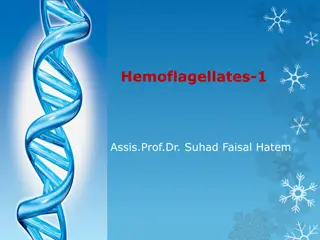Overview of Trypanosomes: Characteristics, Life Cycle, and Diseases
Trypanosomes are hemoflagellates that reside in the blood and tissues of vertebrate hosts and insect vectors. They undergo a complex life cycle involving two hosts and different developmental stages. Trypanosomes cause diseases like African Trypanosomiasis (sleeping sickness) and South American Tryp
0 views • 43 slides
Understanding Hemoflagellates: Leishmania and Trypanosoma Species
Hemoflagellates are blood and tissue parasites belonging to the genera Leishmania spp. and Trypanosoma spp. This article discusses their life cycle, pathogenicity, diseases they cause like visceral and cutaneous leishmaniasis, and diagnostic methods. Special focus is given to Leishmania donovani and
0 views • 14 slides
Medically Important Hemoflagellates: Trypanosoma and Leishmania
Hemoflagellates belong to the phylum Sarcomastigophora and include medically significant genera such as Trypanosoma and Leishmania. These parasites are transmitted by insects and exhibit complex life cycles. Trypanosoma species, such as T. cruzi and T. brucei, cause diseases like Chagas' disease and
0 views • 18 slides


